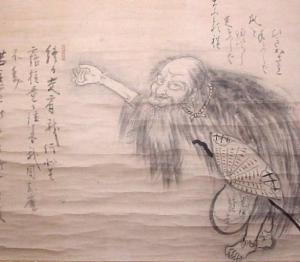Daido Kokushi, also know as Myoho Shucho, was the founding abbot of the great Rinzai Zen monastery Daitokuji.
It was on this day, the 21st of January, in 1324, that he was invited to a debate organized by the former emperor Hanazono between him and representatives of the Tendai and Shingon traditions. At the end of it the emperor declared the Zen monk the winner.
As the emperor was a sponsor of the monk, perhaps not too much should be made of this event.
Still, noticing the date, sparked a few thoughts about the master.
From earlier in his life, there’s a delightful story of how he had chosen to live anonymously as a beggar. And how that very emperor, Hanazono, pulled him back into public ministry.
Richard Bryan McDaniel, in his Zen Masters of Japan tells it.
“The retired Emperor heard a rumor that a Zen master of exceptional ability had come to the city of Kyoto where, instead of establishing himself at one of the city’s temples, he had chosen to live among the derelicts and beggars residing under the Gojo Bridge. The emperor was intrigued by the tale and asked his informant if there were any way that he could identify which of the beggars was the modest Zen Master. All the informant could tell him was that it was rumored the master was particularly fond of honeydew melons.
“Hanazono disguised himself as a fruit peddler and pushed a cart laden with melons to the region by the bridge. As the residents gathered around him, he held up a ripe melon and announced, ‘I will give this melon freely to anyone who can come up to me and claim it without using his feet.’
“One of the beggars immediately challenged him, ‘Then give it to me without using your hands.'”
Revealed, the Zen master was dragged into teaching.
He would become enormously important. I mentioned above how he would become the founding master of Daiitokuji, which would become one of the great Rinzai foundations.
A lovely example of his teaching was captured in this presentation to the Empress Hanazono. (translated by Trevor Leggett and offered in his First Zen Reader):
“All Zen students should devote themselves at the beginning to zazen (sitting in meditation). Sitting… see the original face which was before father or mother was born. This means to see the state before the parents were born, before heaven and earth were parted, before you received human form. What is called the original face will appear. That original face is something without color or form, like the empty sky in whose clarity there is no form.
…The seventeen hundred koan or themes to which Zen students devote themselves are all only for making them see their original face. The World-honored One sat in meditation in the snowy mountains for six years, then saw the morning star and was enlightened, and this was seeing his original face… All this is what is called “meeting the lord and master.”
The body is a house, and it must have a master. It is the master of the house who is known as the original face. Experiencing heat and cold and so on, or feeling a lack, or having desires – these are all delusive thoughts and do not belong to the true master of the house. These delusive thoughts are something added. They are things which vanish with each breath. To be dragged along by them is to fall into hell, to circle in the six paths of reincarnation. By going deeper and deeper into zazen, find the source of the thoughts. A thought is something without any form or body, but owing to the conviction of those thoughts remaining even after death, man falls into hell with its many pains, or suffers in the round of this changing world.
Every time a thought arises, throw it away. Just devote yourself to sweeping away the thoughts. Sweeping away thoughts means performing zazen. When thought is put down, the original face appears. The thoughts are like clouds; when the clouds have cleared, the moon appears. That moon of eternal truth is the original face.
The heart itself is verily the Buddha. What is called “seeing one’s nature” means to realize the heart Buddha. Again and again put down the thoughts, and then see the heart Buddha. It might be supposed from this that the true nature will not be visible except when sitting in meditation. That is a mistake. Yoka Daishi says: “Going too is Zen; sitting too is Zen. Speaking or silent, moving the body or still, he is at peace.” This teaches that going and sitting and talking are all Zen. It is not only being in zazen and suppressing the thoughts. Whether rising or sitting, keep concentrated and watchful. All of a sudden, the original face will confront you.”













